Overview
Marfan syndrome is an inherited disorder that affects connective tissue — the fibers that support and anchor your organs and other structures in your body. Marfan syndrome most commonly affects the heart, eyes, blood vessels and skeleton.
People with Marfan syndrome are usually tall and thin with unusually long arms, legs, fingers and toes. The damage caused by Marfan syndrome can be mild or severe. If your aorta — the large blood vessel that carries blood from your heart to the rest of your body — is affected, the condition can become life-threatening.
Treatment usually includes medications to keep your blood pressure low to reduce the strain on your aorta. Regular monitoring to check for damage progression is vital. Many people with Marfan syndrome eventually require preventive surgery to repair the aorta.
Products & Services
Symptoms
Finger length in Marfan syndrome
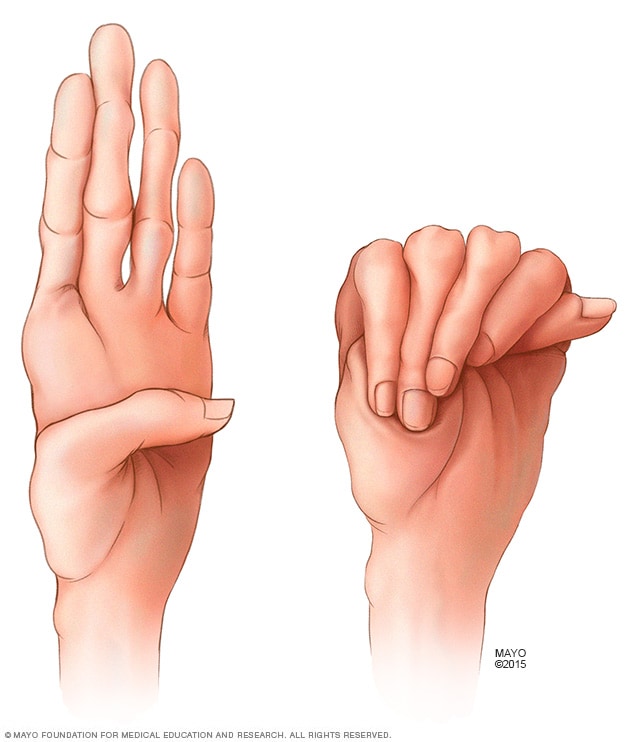
Finger length in Marfan syndrome
People who have Marfan syndrome typically have especially long fingers. It's common for their thumbs to extend far beyond the edge of their hands when they make a fist.
Longer arms in Marfan syndrome

Longer arms in Marfan syndrome
Marfan syndrome is a genetic disorder that causes people to have unusually long arms, legs and fingers. Your doctor may want to measure your arm span if he or she thinks you might have the disorder.
The signs and symptoms of Marfan syndrome can vary greatly, even among members of the same family, because the disorder can affect so many different areas of the body. Some people experience only mild effects, but others develop life-threatening complications.
Marfan syndrome features may include:
- Tall and slender build
- Disproportionately long arms, legs and fingers
- A breastbone that protrudes outward or dips inward
- A high, arched palate and crowded teeth
- Heart murmurs
- Extreme nearsightedness
- An abnormally curved spine
- Flat feet
When to see a doctor
If you think that you or your child may have Marfan syndrome, talk to your doctor or pediatrician. If your doctor suspects a problem, you'll likely be referred to a specialist for further evaluation.
Causes
Marfan syndrome is caused by a defect in the gene that enables your body to produce a protein that helps give connective tissue its elasticity and strength.
Most people with Marfan syndrome inherit the abnormal gene from a parent who has the disorder. Each child of an affected parent has a 50-50 chance of inheriting the defective gene. In about 25% of the people who have Marfan syndrome, the abnormal gene comes from neither parent. In these cases, a new mutation develops spontaneously.
Risk factors
Marfan syndrome affects men and women equally and occurs among all races and ethnic groups. Because it's a genetic condition, the greatest risk factor for Marfan syndrome is having a parent with the disorder.
Complications
Aneurysm at aortic root
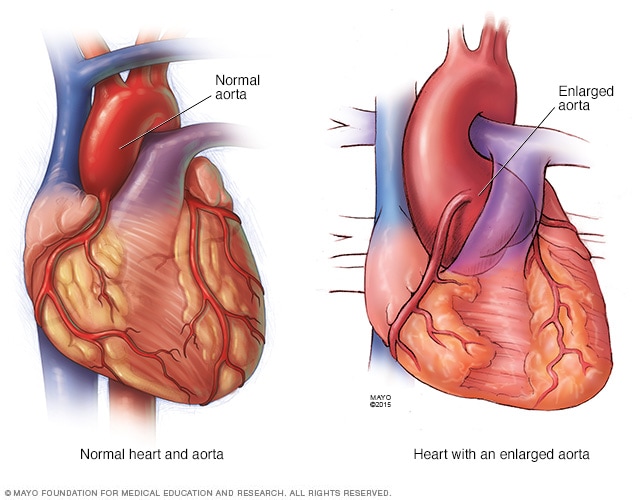
Aneurysm at aortic root
The pressure of blood leaving your heart can cause the wall of your aorta to bulge out, like a weak spot in a tire. In people who have Marfan syndrome, this is most likely to happen at the aortic root — where the artery leaves your heart.
Aortic aneurysm and aortic dissection
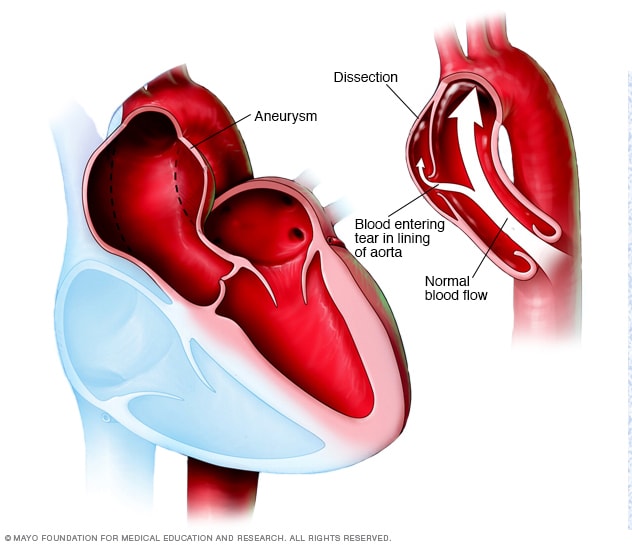
Aortic aneurysm and aortic dissection
An aortic aneurysm occurs when a weak spot in the wall of your aorta begins to bulge (left). This can occur anywhere in your aorta. Having an aneurysm increases the risk of an aortic dissection — a tear in the lining of the aorta, shown in the image on the right.
Lens dislocation
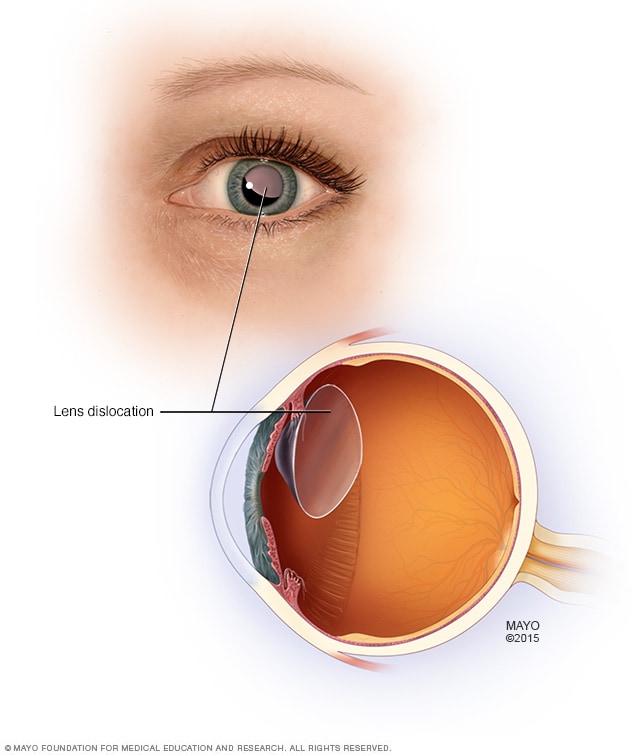
Lens dislocation
Some people who have Marfan syndrome may experience the dislocation of the lens in their eye.
Retinal detachment
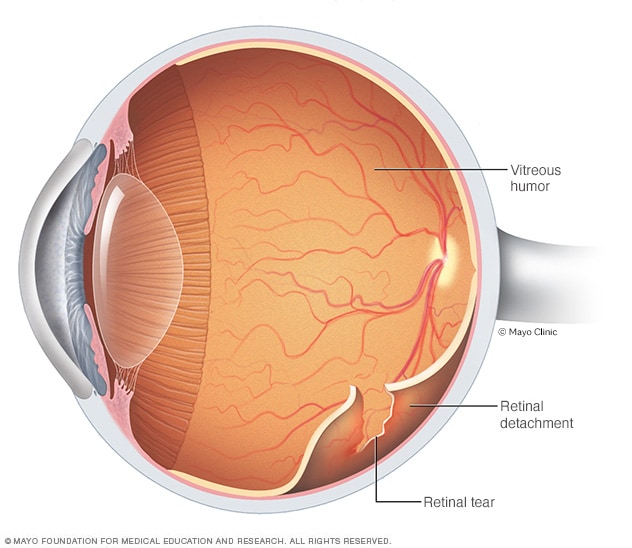
Retinal detachment
Retinal detachment is an emergency situation in which the thin layer of tissue at the back of the eye, called the retina, pulls away from its usual position. Retinal cells separate from the layer of blood vessels that provides the eye with oxygen and nutrients. Retinal detachment symptoms often include flashes and floaters in your vision.
Scoliosis
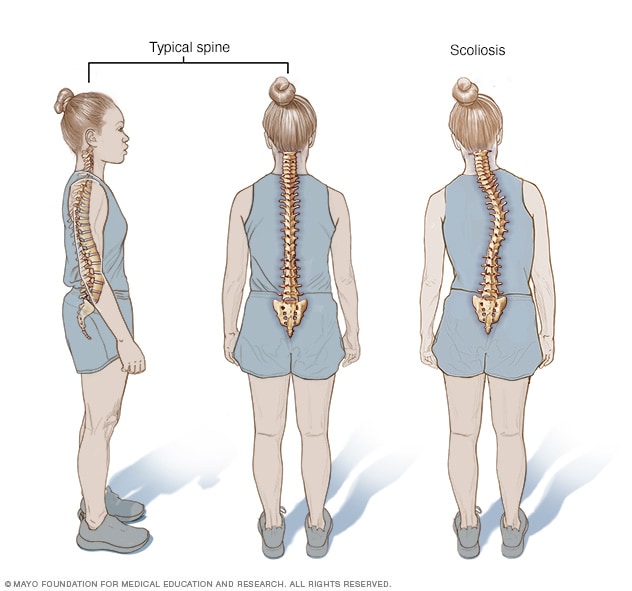
Scoliosis
Viewed from the side, the typical spine takes the form of an elongated S, the upper back bowing outward and the lower back curving slightly inward. Viewed from behind though, the spine should appear as a straight line from the base of the neck to the tailbone. Scoliosis is a sideways curvature of the spine.
Chest abnormalities
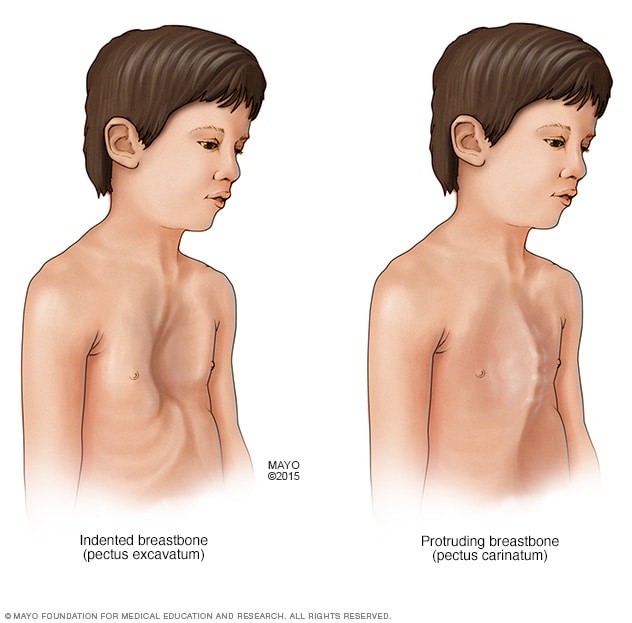
Chest abnormalities
Marfan syndrome can interfere with the normal development of the ribs, which can cause the breastbone to either protrude or appear sunken into the chest.
Because Marfan syndrome can affect almost any part of your body, it may cause a wide variety of complications.
Cardiovascular complications
The most dangerous complications of Marfan syndrome involve the heart and blood vessels. Faulty connective tissue can weaken the aorta — the large artery that arises from the heart and supplies blood to the body.
- Aortic aneurysm. The pressure of blood leaving your heart can cause the wall of your aorta to bulge out, like a weak spot in a tire. In people who have Marfan syndrome, this is most likely to happen at the aortic root — where the artery leaves your heart.
- Aortic dissection. The wall of the aorta is made up of layers. Dissection occurs when a small tear in the innermost layer of the aorta's wall allows blood to squeeze between the inner and outer layers of the wall. This can cause severe pain in the chest or back. An aortic dissection weakens the vessel's structure and can result in a rupture, which may be fatal.
- Valve malformations. People who have Marfan syndrome can have weak tissue in their heart valves. This can produce stretching of the valve tissue and abnormal valve function. When heart valves don't work properly, your heart often has to work harder to compensate. This can eventually lead to heart failure.
Eye complications
Eye complications may include:
- Lens dislocation. The focusing lens within your eye can move out of place if its supporting structures weaken. The medical term for this problem is ectopia lentis, and it occurs in more than half the people who have Marfan syndrome.
- Retinal problems. Marfan syndrome also increases the risk of a detachment or tear in the retina, the light-sensitive tissue that lines the back wall of your eye.
- Early-onset glaucoma or cataracts. People who have Marfan syndrome tend to develop these eye problems at a younger age. Glaucoma causes the pressure within the eye to increase, which can damage the optic nerve. Cataracts are cloudy areas in the eye's normally clear lens.
Skeletal complications
Marfan syndrome increases the risk of abnormal curves in the spine, such as scoliosis. It can also interfere with the normal development of the ribs, which can cause the breastbone to either protrude or appear sunken into the chest. Foot pain and low back pain are common with Marfan syndrome.
Complications of pregnancy
Marfan syndrome can weaken the walls of the aorta, the main artery that leaves the heart. During pregnancy, the heart pumps more blood than usual. This can put extra stress on the aorta, which increases the risk of a deadly dissection or rupture.